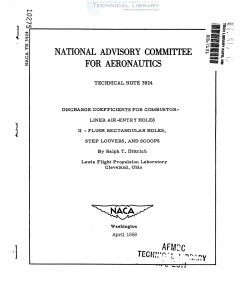naca-tn-3924
- Version
- 134 Downloads
- 2.20 MB File Size
- 1 File Count
- January 31, 2017 Create Date
- January 31, 2017 Last Updated
National Advisory Committee for Aeronautics, Technical Notes - Discharge Coefficients for Combustor-Liner Air-Entry Holes - II - Flush Rectangular Holes, Step Louvers, and Scoops

An experimental inyestigation was conducted to determine discharge
coefficients for various types of combustor-liner air-entry holes such
as flush rectangular holes, step louvers, and scoops. The data presented
herein show the variation in discharge coefficient of each configuration
as a function.of a dimensionless flow parameter. Within the range investi—
gated, the effect of size or shape of flush holes on discharge coefficient
was small compared to the effects of duct stream velocity or pressure
ratio across the hole. While the addition of a scoop to a flush hole
increased the discharge coefficient only at low values of the flow param—
eter, the step louver and the thumbnail—type scoop increased discharge
coefficients throughout the range of the flow parameter. However, at low
values of the flow parameter, the discharge coefficients for scoops and
step louvers were affected by boundary-layer conditions of the duct
stream. The proximity of multiple flush holes or the wall inclination
of a convergent duct had a negligible effect on discharge coefficient.
With the trend toward greater air loading and higher air velocities
through turbojet combustors, a knowledge of discharge coefficients for
liner wall openings is essential for the design of aerodynamicalky effi-
cient combustors. Discharge coefficients for flush circular holes with
flow parallel to the plane of the hole are presented in reference 1. The
present investigation extends the work of reference 1 by presenting dis—
charge coefficients for various other types of liner wall openings such
as slots, scoops, and louvers.
With flush circular holes (ref. 1) the effects of hole diameter and
wall thickness at the hole on discharge coefficients were small compared
with the effects of external parallel flow velocity and pressure ratio
across the hole; the effects of duct height, pressure level, and boundary—
1ayer thickness were negligible. Application of the data of reference 1
to calculated flow conditions in a model combustor (ref. 2) indicates
that for flush circular liner wall holes the discharge coefficient may
vary from approximately 0.2 to 0.6.
| File | Action |
|---|---|
| naca-tn-3924 Discharge Coefficients for Combustor-Liner Air-Entry Holes - II - Flush Rectangular Holes, Step Louvers, and Scoops.pdf | Download |

Comment On This Post